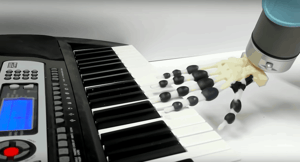Bioengineers from the University of Cambridge (Great Britain) have succeeded in a bold endeavour, from a technological point of view: to make a robotic hand, with the help of a 3D printer, that plays the piano, albeit rudimentarily. This accomplishment is described in an article published in the journal Science Robotics, and illustrated in a video in which the hand plays a Christmas song, among other tunes.
The hand, printed using several artificial elements very similar to those of human limbs – such as tendons, muscles and bone – and then connected to a computer that controls its activity, only moves its wrist, i.e. makes a passive movement, but its rotation and movement capacity in general is so refined that it can reproduce several kinds of tunes, including the staccato and legato styles, which are well-known to musicians.
The hand is one of the most complex points of the human body, and its movement depends on the coordination of reactions of the brain, the processing of the senses (for example, hearing and sight) and the correct functioning of the mechanical parts (tendons, muscles and so on): a highly complicated set, so much so that several scientists speak of an “incorporated brain” to describe a kind of intelligence capable of controlling all the necessary actions (in a partially independent way). For these reasons, reproducing subtle movements like those required to play an instrument has always been considered an ambitious, if not unachievable, goal.
Now, however, the work of the British engineers has opened up new avenues, which will also be useful for the design of robots that are similar, but used, for example, in high-precision medical actions, or for industrial purposes.
Currently, as already stated, the sound of the artificial hand made in Cambridge is created only through the (very sophisticated) movement of the wrist, which makes it possible to guide the fingers to the correct key, and to apply the right “weight”. Further important developments are already being studied, in order to achieve the completely autonomous movement, i.e. active movement, of the fingers in the near future.

